Living in the Shadow of Nextwave: A Look at the Making and Magic of a Comic Book Cult Classic
“It’s like Shakespeare/But with lots more punching.”
So begins the theme song to Nextwave: Agents of H.A.T.E., a 12 issue series from 2006-2007 by writer Warren Ellis, artist Stuart Immonen, inker Wade von Grawbadger, colorist Dave McCaig, letterers Chris Eliopoulous and Joe Caramagna, and editor Nick Lowe. Just because of that, you know this isn’t your average comic book series. I mean…it has a theme song. Fans of the book know this isn’t just throwaway track either; it’s a mission statement of sorts, representing the fervor the series inspires in readers. Take The AV Club’s comic critic Oliver Sava, for example, who immediately mentioned the song when asked what he loves about the series.
“It has a theme song. That’s only a semi-joke,” Sava told me. “Nextwave’s theme song tells you that it’s not just different from other superhero comics, it’s special.”
Nextwave is an atypical series for any publisher, but for Marvel Comics, a publisher that’s arguably the first thing people think of when they hear the word “superheroes,” it’s especially odd. It’s a superhero comic that simultaneously perfected and made fun of the genre, with both of those knobs turned to 12 because 11 is just not enough. That’s a huge part of what makes it special to Farmhand’s Rob Guillory.
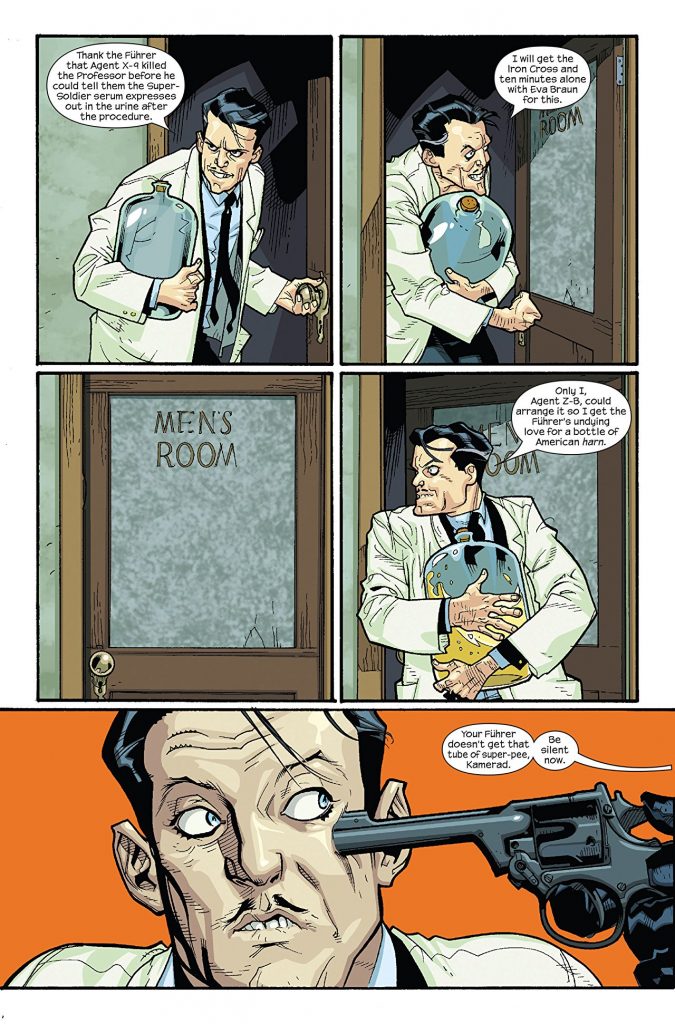
“I just love how it celebrates so much about what I love about Marvel Comics, while also poking fun at how ludicrous it all is,” Guillory said. “I mean, what other comic has even given Captain America’s urine screen time? That’s fantastic.”
It’s the perfect comic book, with the essence of everything great from superhero comics boiled down to its purest form and then fed to us through a fire hose powered IV drip over a series of 12 issues. While its plot is ostensibly a classic of good versus evil, as a cadre of C-list at best superheroes team up to take on their former employer who happens to be funded by a rebranded terrorist organization, it’s secondary to the comic in a way few ever are. It’s really a delivery device for absurdity, firing madcap ideas at us as rapidly as a human could possibly handle them. That made – and continues to make – it stand out amongst its peers.
“Nextwave came out at the height of my superhero addiction, when I was making enough money in college to buy way too many superhero comics for my own good. When you’re caught in the spell, you don’t realize how similar everything is until you’ve experienced something different,” Sava told me. “Nextwave gave me what I didn’t know I needed: a gonzo superhero book that gave no fucks as it threw a gang of misfits into increasingly insane scenarios.”
It’s the closest the medium of comes has to a true cult classic. While it was never a top seller or even one that did big enough numbers to allow the series to survive beyond 12 issues, creators hold it close like a Holy Bible of insanity while readers evangelize it to anyone who will listen. I should know. There’s no comic I enjoy more, and I am not shy about making people aware of that fact.
It’s also the rare Marvel comic with a passionate fan base that has never seen a second volume, even with a vast span of 12 years since we last saw it. 1 In a medium that loves playing back the hits, no matter how small of one they were, that makes it even more unique. 2
So what went into making this wondrous and absolutely mad comic book? How did the industry’s biggest purveyor of superhero wares get into the business of publishing a comic that was said to be “Like Titanic/But the boat’s still floating/No it’s not!/The motherfucking boat is exploding!” 3 if only for a year’s worth of issues? Let’s find out from some of the people who made it.
The roots of Nextwave all begin on another title. It’s one that you probably wouldn’t typically associate with it: Ultimate Fantastic Four. Ellis, Immonen and Lowe were wrapping up a run on the series set in the now defunct 4 offshoot of the main Marvel line. Lowe didn’t want the party to stop, even if he and Immonen were still working together on other titles together.
“I told Warren ‘I’d love to work with you on something else. This was too fun,’” Lowe said. “And so he sent me this pitch for Nextwave, and I read it, and I thought, ‘This is amazing.’
“There is no way we will publish it.”
Ellis 5 came up with the concept for Nextwave when writer Brian Michael Bendis lamented that no one had followed up his reinvention of superhero teams in New Avengers with an effort of their own. He saw that as a challenge.
“How can I really horrify Bendis?” Ellis wondered. “What could I do that would just scare the shit out of him and make him utterly regret saying that? So I took The Authority and I stripped out all the plots, logic, character and sanity. I just cut everything back until I was left with pure superhero comics.”

When you read that, it’s easy to understand Lowe’s trepidation. The pitch document underlined the potential concerns even further. From the jump, the Nextwave pitch had almost everything we came to know and love the series for. The document—which Lowe still has on his computer, despite receiving it on February 22nd of 2005—started stream of consciousness with six simple words: “In the pub, it’s snowing outside.” It quickly dove into everything that made Nextwave Nextwave. The core cast, the villains, Fin Fang Foom, its two issue arc structure, 6 you name it. It even had one of the title’s most famous catch phrases at its conclusion.
“It ends with ‘Totally over the top, Authority to the 10th power, old Marvel monsters, giant robots, the explodo, people getting kicked, Nextwave, healing America by beating people up.” Lowe told me.
That doesn’t really sound like it’d be in Marvel’s wheelhouse, especially in 2006-‘07 during the peak of Civil War and event mania. Lowe was an assistant editor in the Ultimate office at the time, and as much as he loved the pitch, “I thought there was no way.”
“(Ellis) emailed it to me, and when he emailed it to me, he copied Joe Q, 7 who was Editor-in-Chief at the time. And as soon as I said there was no way we would publish it, an email from Joe came in that said, ‘I love this, we’re doing it.’”
Quesada’s word was bond, and with his approval, it was “off to the races,” as Lowe told me. It was time to find the right team to bring this tour of insanity to life. It started on the art side, and Lowe wasn’t the only one who enjoyed working with Immonen on Ultimate Fantastic Four. Ellis specifically requested the renowned artist. There was one hitch with that plan, though.
“At the end of their arc on Ultimate (Fantastic Four), it had ended somewhat crazily,” Lowe said. “(Ellis) was writing two arcs at the same time, and he had either gotten ill or overbooked – and I think it may be the latter – so he fell behind. He barely kept Stuart up with scripts. He had done his best. He’s a very in demand guy.
“But the last issue they did together, it was really just a one-page plot document that Stuart then broke into pages and did all the visual storytelling on, and even the page-to-page and panel-to-panel of,” Lowe added. “Warren was so out of pocket that he couldn’t even do that. And then Warren came in and added dialogue. That was the only kind of Marvel Style book that I ever did with Warren, and I’ve worked with Warren off and on for the last 15 years.”
Lowe described Stuart as “a consummate professional,” and because of his efforts to always hit deadlines, “it drove Stuart a bit crazy.” That led to the following interaction, which Lowe recounted to me.
“Warren suggested him (for Nextwave), so I called Stuart and I said, ‘Stuart, I’ve got a new project that I think you’d be perfect for that we want you for,” Lowe told me. “And he said, ‘As long as it’s not with Warren, I’m in, Nick.’
“’Well, you might not like where this is going then.’”
Lowe walked him through the idea anyways, sending him the pitch document while fully believing he would ultimately have to find a different direction for the artist of the book. Thankfully for all of us, he didn’t have to.
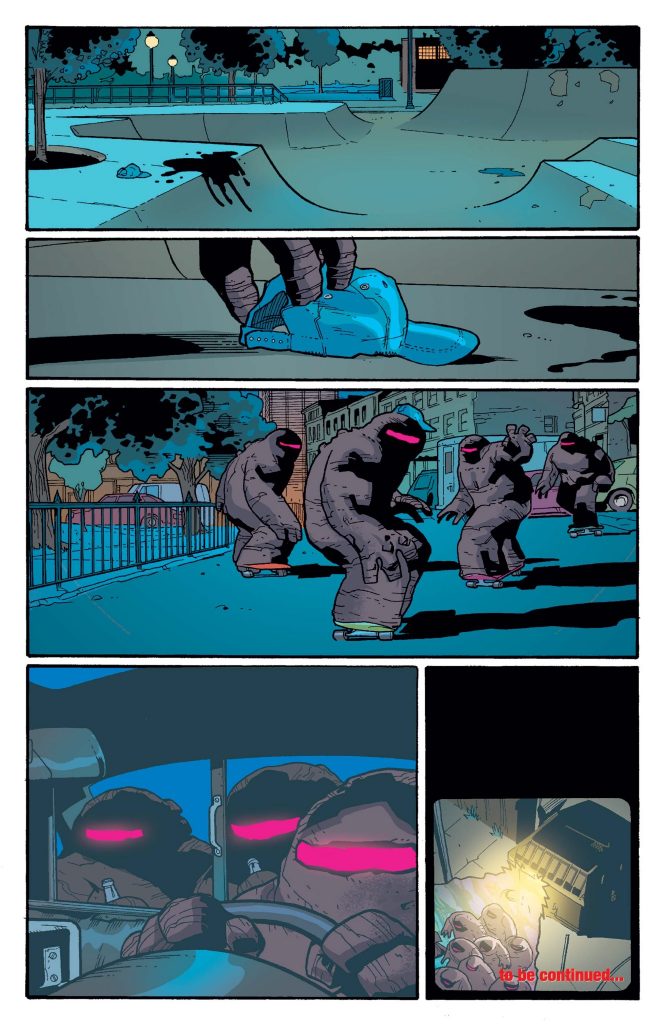
“(The pitch) was a riot and that I thought it would fit with what I wanted to do stylistically at the time,” Immonen said. “I’d come off a run on Ultimate X-Men where I didn’t feel like I was doing what the writer liked very much, but I’d had my fill of doing more naturalistic work on Superman: Secret Identity. I was feeling pretty adrift and Nick’s enthusiasm is like a riptide; he’s very convincing while he’s carrying you out to sea.”
It helped that Ellis was ahead of schedule from the jump, with three or four issues already in the can by the time Immonen had heard of it. That “alleviated any concerns” Immonen had on the scheduling front. It also underlined how special the project was to Ellis, in Lowe’s mind. The Marvel editor often spent those days waiting on scripts from Ellis, but the legendary scribe was always three scripts ahead on Nextwave. The reason for that?
“The feeling I got at the time was he just loved it,” Lowe said. “It was just easy for him because it was a joy.”
Lowe handpicked the rest of the team, as he needed a special set of creators to bring this comic to life. The initial recruits were two seasoned veterans who are amongst the best in the business at what they do.
“I remember Nick Lowe coming to me and asking me to personally letter it,” letterer Chris Eliopoulos told me. “Nick tried to explain what this was about and how they were looking for something different with graphics and the characters. It sounded like a lot of fun. At the time, I’m sure I thought of it as another book to work on, but once we got started, I thought this was either going to be so amazing or no one would like it.
“But when Warren is writing, chances are it’ll be great.”
Dave McCaig was the pick on the color side of the book, and it was an easy pitch for him.
“Nick Lowe asked if I wanted to work on a goofball, light-hearted superhero comic, and I was all-in,” McCaig said. “Most other comics at the time were pretty serious, and it was a real treat for me to stretch my cartoon-y muscles. Comedic and light-hearted stories allow for a broad range of color and expressive style.
“Plus, you tend to get into the mood of whatever you’re storytelling, so funny books are obviously fun to work on.”
With the team assembled, it was time to make the book. And while the foundation – the creators themselves – was great, this was a title where the sum of its parts were greater than even the prodigious talents working on it.
Nextwave had a rather atypical core idea for superhero comics. The genre of superheroes is one that’s heavily plot driven, with Marvel especially leaning in that direction – they’re largely built on the premise that they’ve been telling the same story since the publisher first burst into the zeitgeist with 1961’s Fantastic Four #1 – even if its approach to character is a key component of what they’re all about. This was not that. As Ellis said in an interview once, “There are no plots at all frankly.”
“Each story is 44 pages long in two issues. Each 44 page block is dealing with one of these things that the Beyond Corporation have set loose in obscure cities, in the middle of the country, where the rest of the Marvel Superheroes don’t go; because it’s not New York and they don’t get their Soy Latte in these areas,” Ellis said. “There are stories. I’m trying to keep them as compact and simple as possible to make space for the jokes and let Stuart Immonen go.”
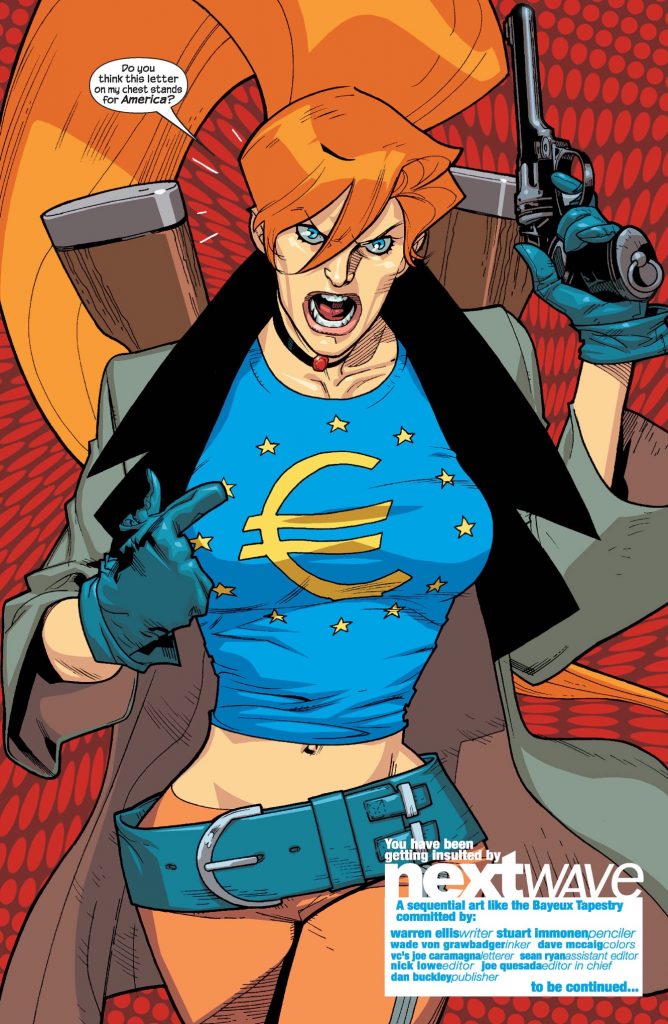
While Lowe admitted much of what Nextwave was came from making fun of superheroes, he did say, “You can tell Warren loves this stuff.” In fact, he viewed Nextwave as a melting pot of things Ellis loved.
“Even when we were starting out, I wanted to figure out how I could best help him with this, and he gave me kind of a watching list. On that watching list was FLCL,” 8 Lowe said. “Then the other one was Zu Warriors, a Chinese fantasy movie. It’s this crazy, Crouching Tiger on drugs movie that’s action and adventure with these crazy magical powered people, and it’s all so ludicrously insane. Those were two big inspiration points for him, as well as superhero stuff. He was always trying to both make fun and celebrate the genre and the characters in such fun ways.”
In a way, the book stemmed from Ellis’s desire to deconstruct his own work, as well.
“With (Nextwave), I kind of looked at Authority, studied it, and thought what slows this down? And, after a while, I realized what slows down its pace is logic, character, and sense,” Ellis said. “Once you take all of those things out, it’s sort of like starting out with Cocaine and baking it down into a crack rock. I really wanted to cook this down to the essence of an action book, where things can be ridiculous, just as things in a video game can be ridiculous, but it doesn’t take away from the experience of it and the fun.”
Video games are a surprisingly great parallel for the series, as you could look at each two-issue arc as a level with each story within a story concluding with a boss fight. The pinnacle of that feeling, of course, comes in issue #11, in which 12 consecutive pages are dedicated to a side-scrolling battle between the squad and everything the Beyond Corporation has left on its floating terror factory. It’s how Ellis envisioned it from the beginning, as Lowe read the script for pages 10 and 11 from that issue to me when we chatted.
“What follows is a sequence of six double page spreads. Imagine them as single long picture. Imagine that picture as a side-scroller video game. That kind of angle, as the team progresses from one end of a long tunnel to the other, left to right. As they progress through the tunnel they are attacked by six different waves of freaky bastards created as terrorist devices by the Beyond Corporation. Are you with me so far? A continuous background that you obviously can vary with gradations so far. What’s going to attack them? Well, all the bullshit they’ve been fighting for the last ten issues was made here. And there’s going to be loads more absurd crap where that came from. We should probably start out with some things Marvel wouldn’t ordinarily take credit for like It the Living Colossus or the Head Man 9 or something…but there should be more of them. A mob of living colossi and head men, heavily armed.”
Every double page spread was much the same, with details like “And if you’ve got King Kong then you need biplanes, it’s the 21st Century, so these biplanes should have snakes built in to them. Venom spitting cyber pilot snakes strafing the other three as they try to blow monsters out of the sky” continuing to add up, until the final two pages were basically Lowe and Immonen’s time to shine, with the script calling it their “last chance to go insane in a double page spread.” According to Lowe, that many double page spreads was “the most (Marvel) could do for how we print things.”
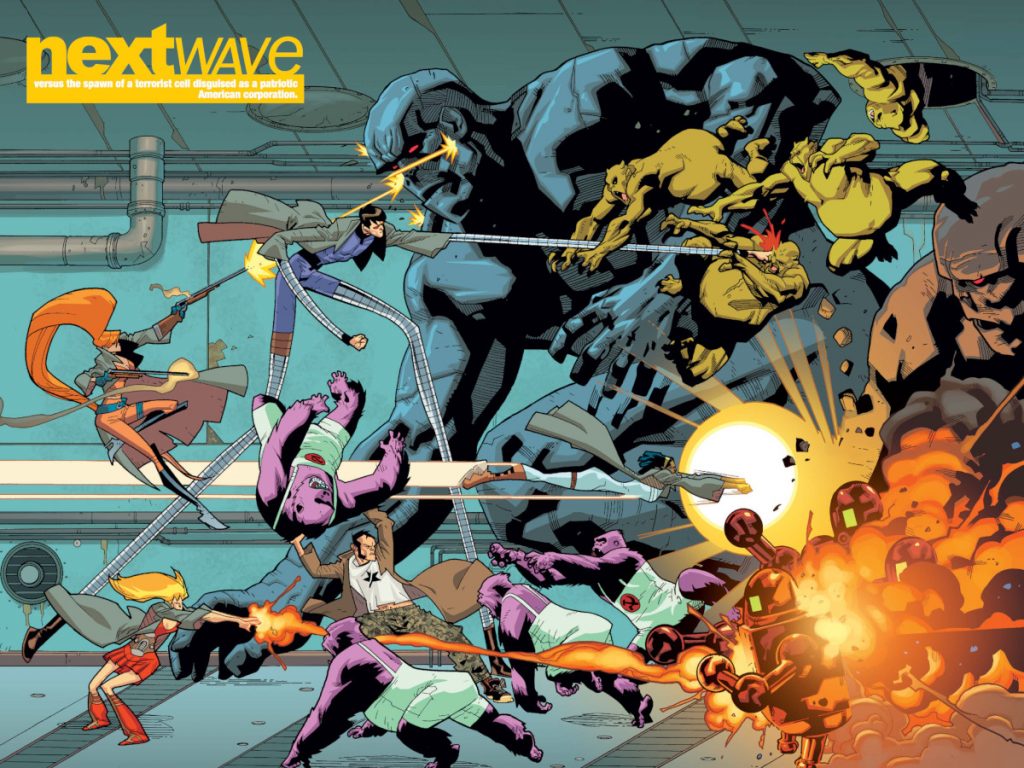
All six spreads from Nextwave #11 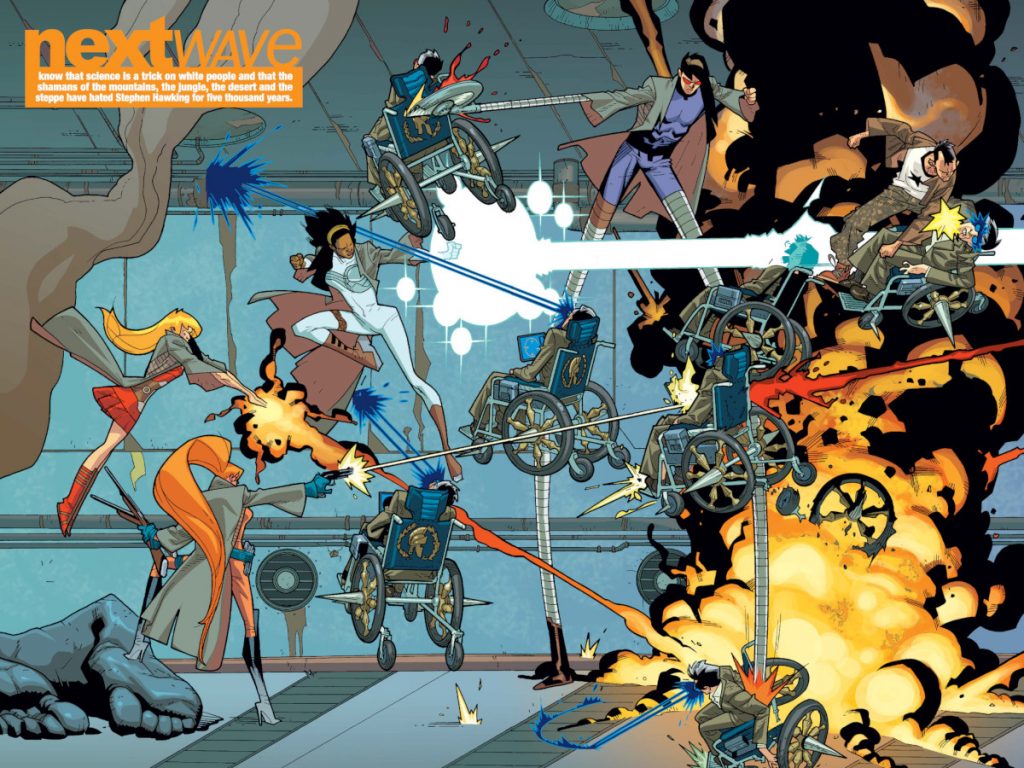
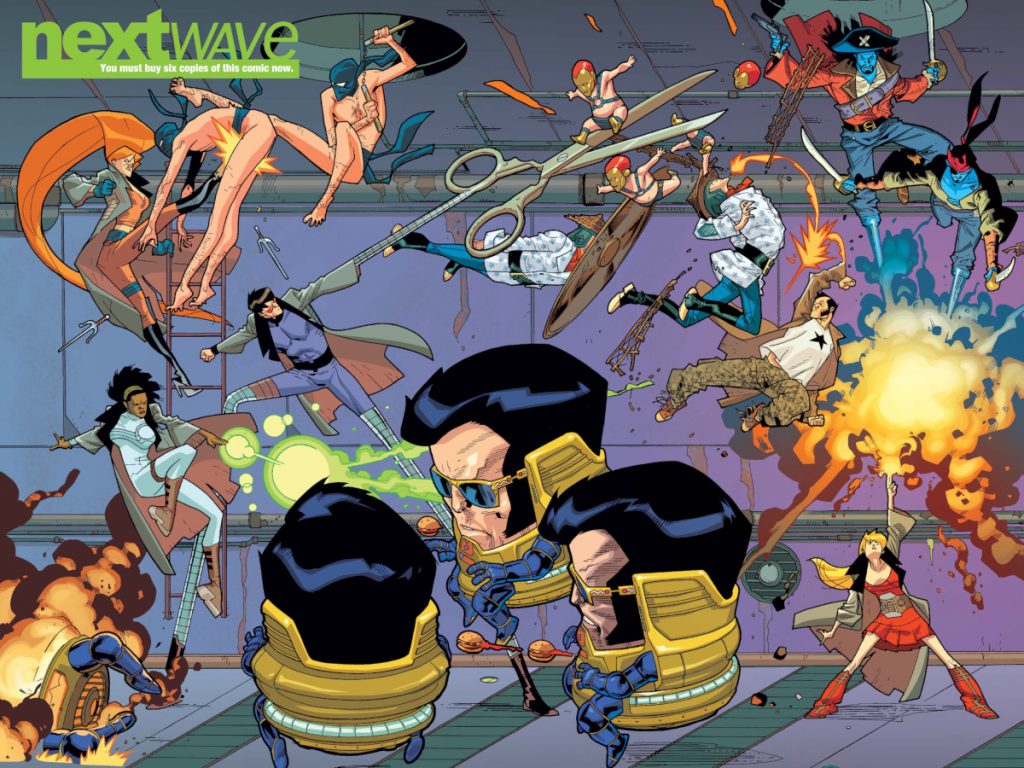
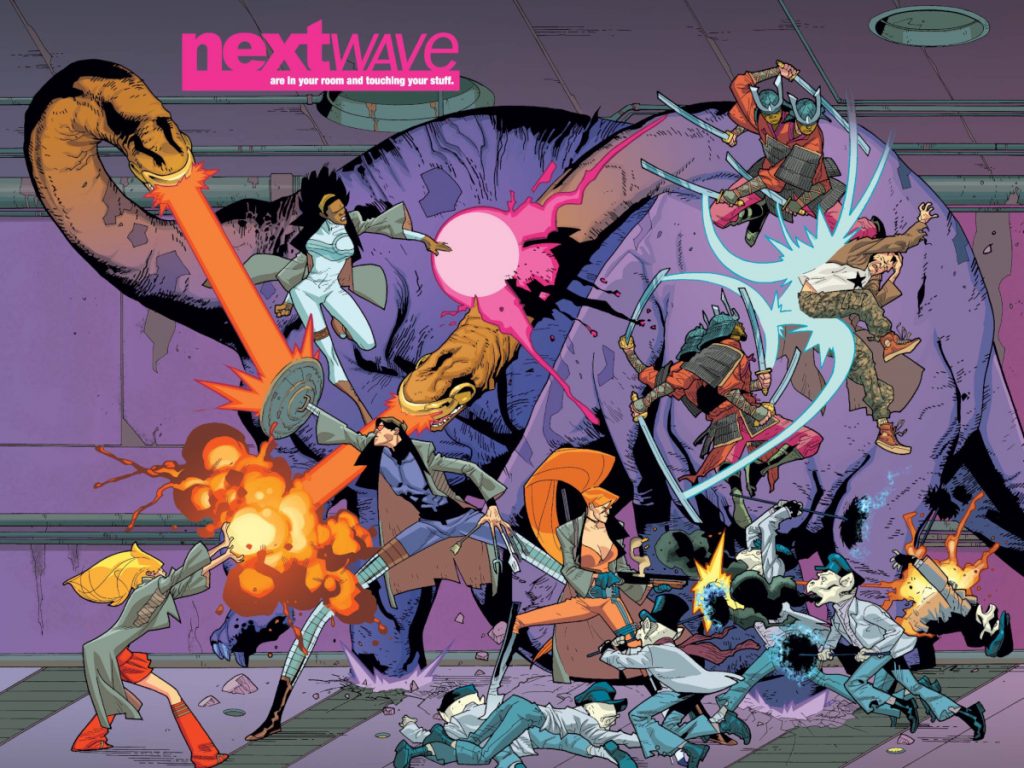
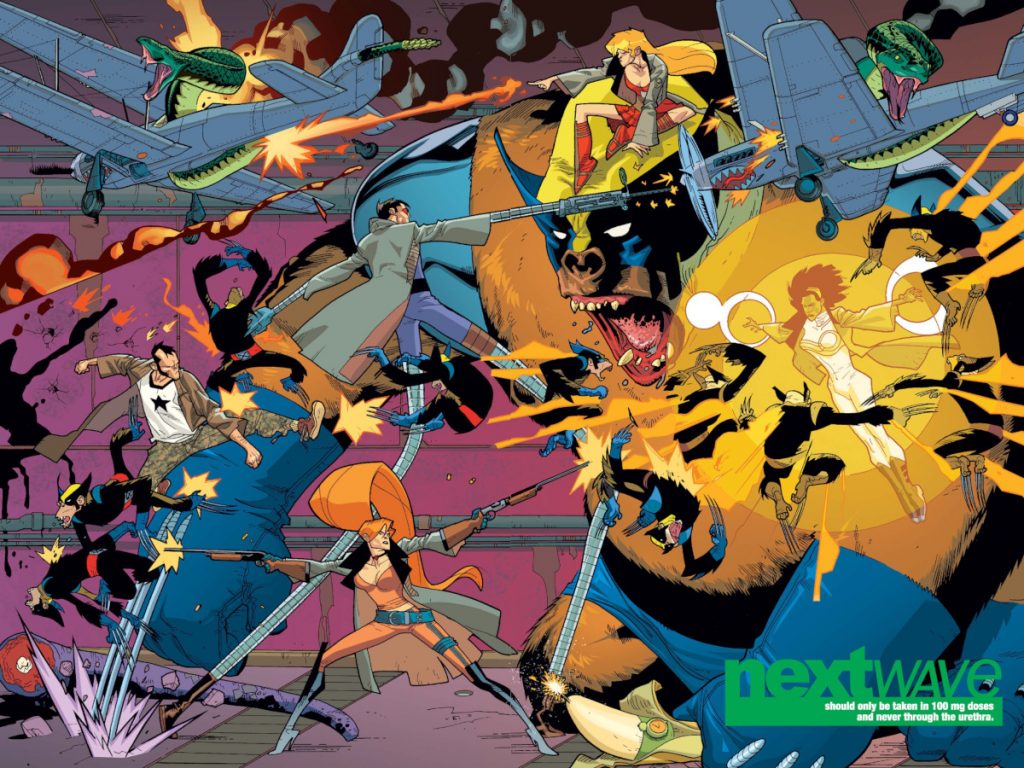
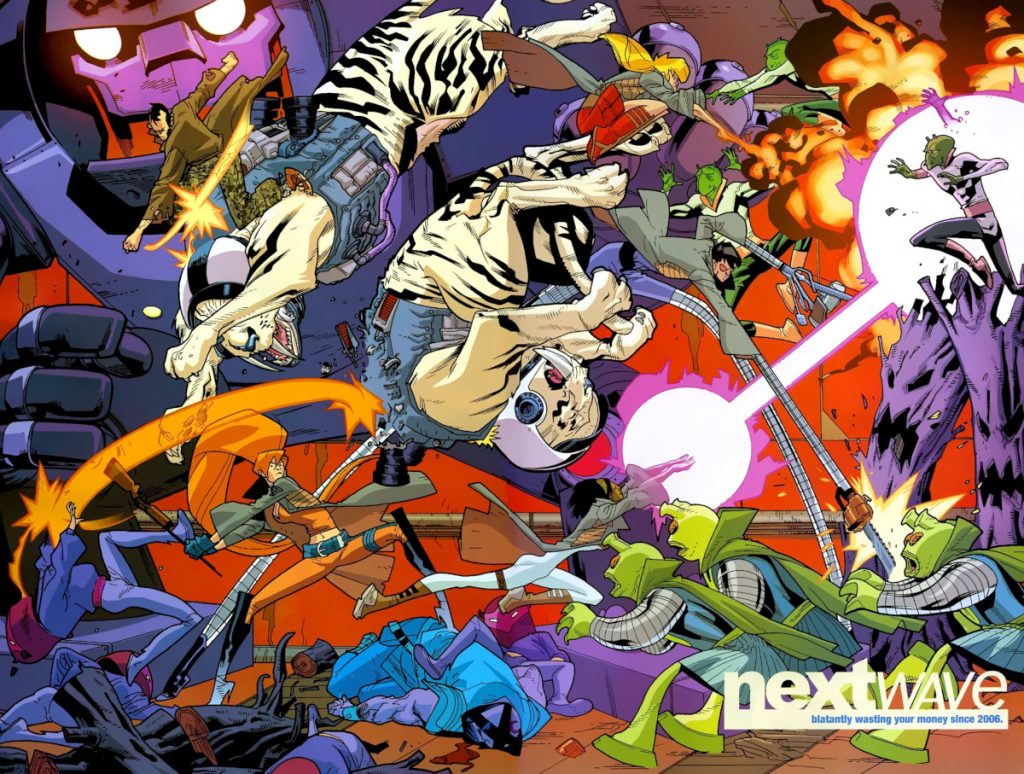
Immonen has “a strong aversion to doing work twice,” so this entire sequence – incredibly – wasn’t mapped out ahead of time.
“I tend to draw off the cuff – which, while it’s served me pretty well, comes with its own problems — and that’s what happened here,” he told me. “There was no story in the bit, so it was really a compositional problem to solve, and to get as many of Warren and Nick’s villain suggestions in as possible.
“I probably could have done a lot more, but mentally it felt like one thing, so by day four or five it was probably becoming more challenging than fun, and into the second week I would start to run out of steam,” Immonen added. “In cases like that, it’s often better to spread out the work, to start from the middle and do bits all over, so your flagging energy isn’t so obvious.”
If you’ve read the series, you know his “flagging energy” was not obvious, as it’s the sequence that’s most commonly mentioned when the greatness of Nextwave comes up. It’s also arguably the most representative section of the book when it comes to the vibe of the series: superhero comics in its most pure form, with all of the punching, kicking and Elvis M.O.D.O.K.s a human could possibly handle.
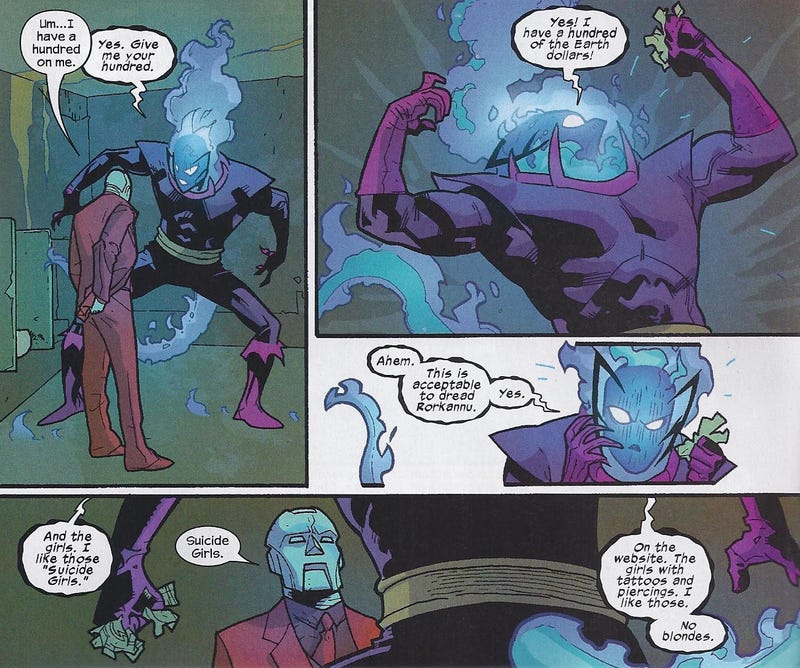
The interesting thing about all of this, though, is despite what some believe, the series is in Marvel continuity. That’s right. A comic that suggests The Avengers have a moderate harassment problem, 10 features a Faltine lord that’s obsessed with Suicide Girls, posits that Forbush Man might be one of the most powerful characters in the Marvel Universe, and all kinds of other bonkers ideas was one that they “did try to keep in continuity,” or at least as much as possible, according to Lowe. He had a perfect story to illustrate that idea.
“When this book came out, Ralph Macchio was my boss,” Lowe said of the long-tenured Marvel editor, whom Lowe described as one of the greatest editors of all time. “When Ralph read the pitch, he did not like it because he doesn’t like people making fun of superheroes just because it’s too important to him. But one of the notes he gave me on the pitch was, ‘Remember Nick, last time Machine Man was in comics, he flew off with the Celestials.’ And that was one of the only notes I had given Warren because Warren was dealing with Machine Man and he didn’t talk about that at all.
“And it’s because of that note that Ralph gave that we get the incredible scene with the Celestial making the L sign on his forehead calling Machine Man a loser,” Lowe continued with a laugh. “I remember after Ralph read that revision, he was like, ‘I regret giving that note.’”
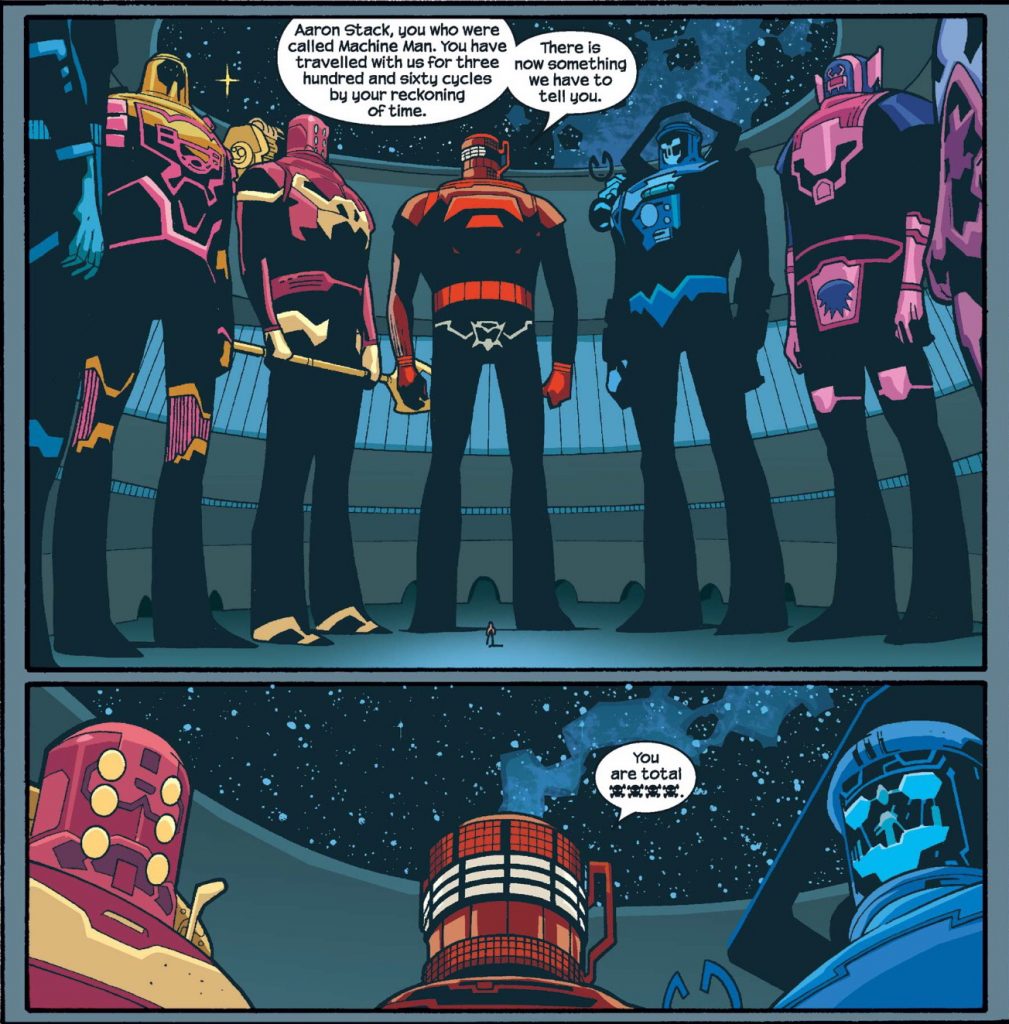
Aaron Stack hanging with Celestials, from Nextwave #5 
Speaking of the title’s arguably most beloved character, let’s talk about the cast. One of the most shocking things about Nextwave and the adoration many have for it is it’s a Marvel comic that stars what can only be described as a motley crew of heroes. The team includes:
- Team leader Monica Rambeau, a former Avenger team leader who was between superhero monikers at the time and long past her prime as an Avenger 11
- The aforementioned Machine Man, also known as Aaron Stack, a character who loves and hates humans – whom he repeatedly calls “fleshy ones” – and hadn’t appeared in a Marvel comic in six years
- Tabitha “Boom Boom” Smith, a former New Mutant and X-Force member who blows things up and was the resident young person, which also made her mystifying to the rest
- Elsa Bloodstone, a British, monster hunting badass who had barely appeared before and was following the legacy of a character almost no one remembered
- The Captain, a creation of this series who got his powers from aliens while he was wasted. This led to him knocking them unconscious because he thought they were leprechauns and that punching leprechauns earned you coins. He is not smart. 12
It’s not exactly a murderer’s row of heroes, and that made things a bit easier for Immonen from a design standpoint.
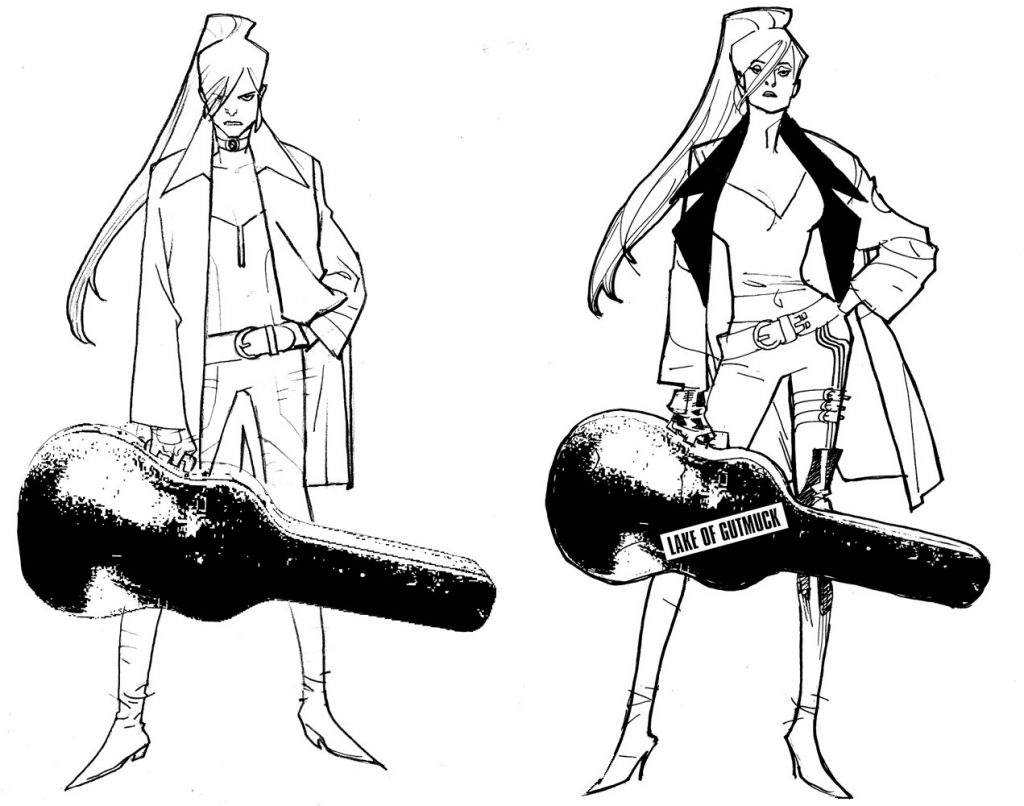
“I didn’t have a lot of personal history with any of the existing characters, which I think actually helped. I do recall that Nick thought my first go at Elsa was maybe too severe, so she ended up being more glamazon-y.” Immonen said. “And the brief was everything was kind of crap, so tropes like the trenchcoats and the 90’s pouches were up the right street. I think Nick basically approved every first take. At the beginning, I would email him and Warren with lots of questions about how various things would work or look like, and they were both pretty hands-off, which made my job a lot easier, and formed my collaborative platonic ideal.”
Even the villains were “kind of crap,” as Immonen put it. Much of the cast stemmed from Ellis having a limited background with the Marvel universe upon starting there, which led to one employee at the publisher attempting to help him become acquainted with its characters.
“When I did my first round with Marvel in the ’90s, one interested editor – in an attempt to destroy my brain – had the entire Marvel Universe Handbook copied and Fed-Exed to me. Every now and then, I would page through this, and just be astonished at how some of this stuff got published,” Ellis said. “So, I really just need to page through this moldering photocopied book. It’s like if the Bible had been assembled by the inmates of five lunatic asylums. You can really just cherry pick this stuff.”
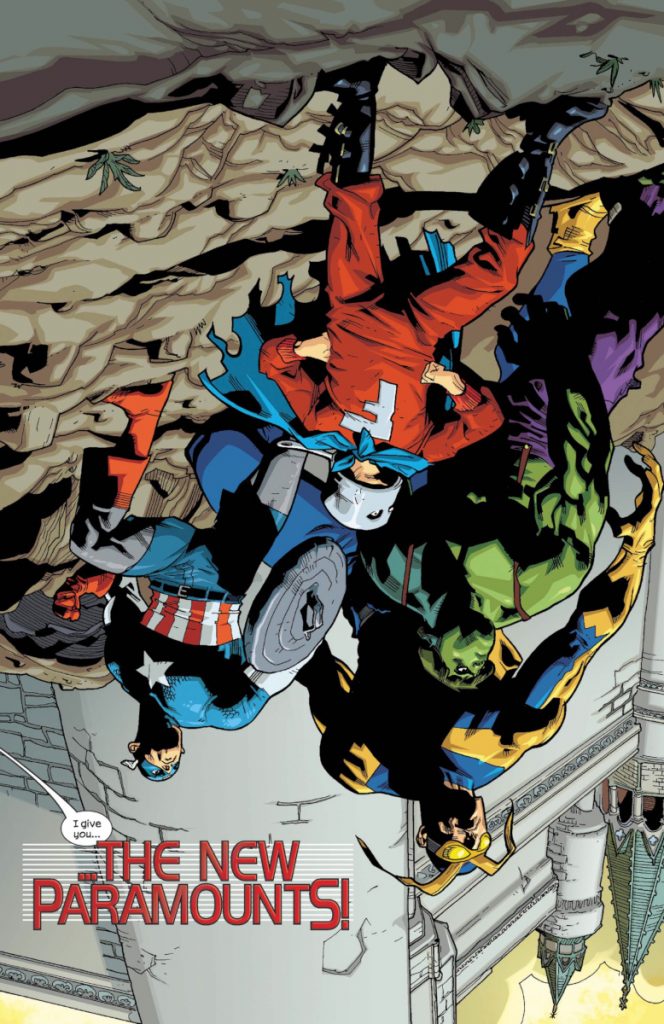
The villains eventually included Fin Fang Foom, 13 a 300 foot tall robot without knee joints called Shogun Warrior, eventual all-ages star Devil Dinosaur, 14 and a slew of the Not Brand Echh! characters that once made fun of superheroes before Nextwave got there. Those characters – newly rebranded as The New Paramounts – were late additions you wouldn’t be able to find in the initial pitch document, but messing with them and in particular their ostensible leader in Forbush Man appealed to Ellis. This “lunatic idea,” as Lowe described it, led to one of the creative highlights of the series.
When the newly immensely powerful Forbush Man used his powers—”Forbush-vision,” as he called it—it sent the cast 15 into their own universes where their stories were depicted in art styles tailored to each character. Immonen drew them in a fashion that matched luminaries like Mike Mignola, Daniel Clowes and Paul Pope, and the idea to do that came from Lowe.
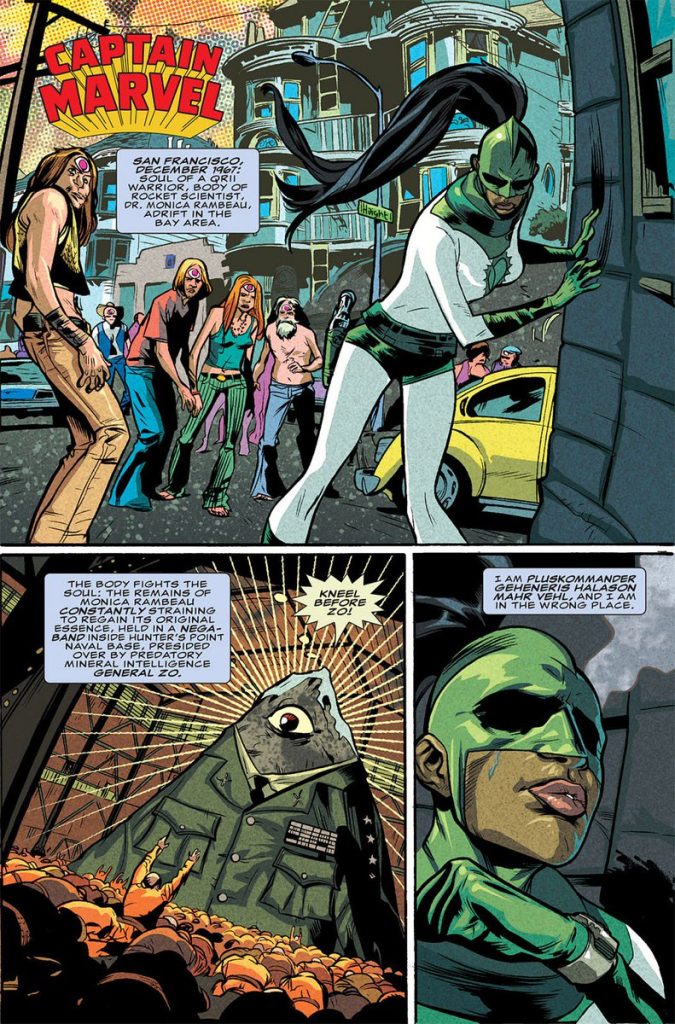

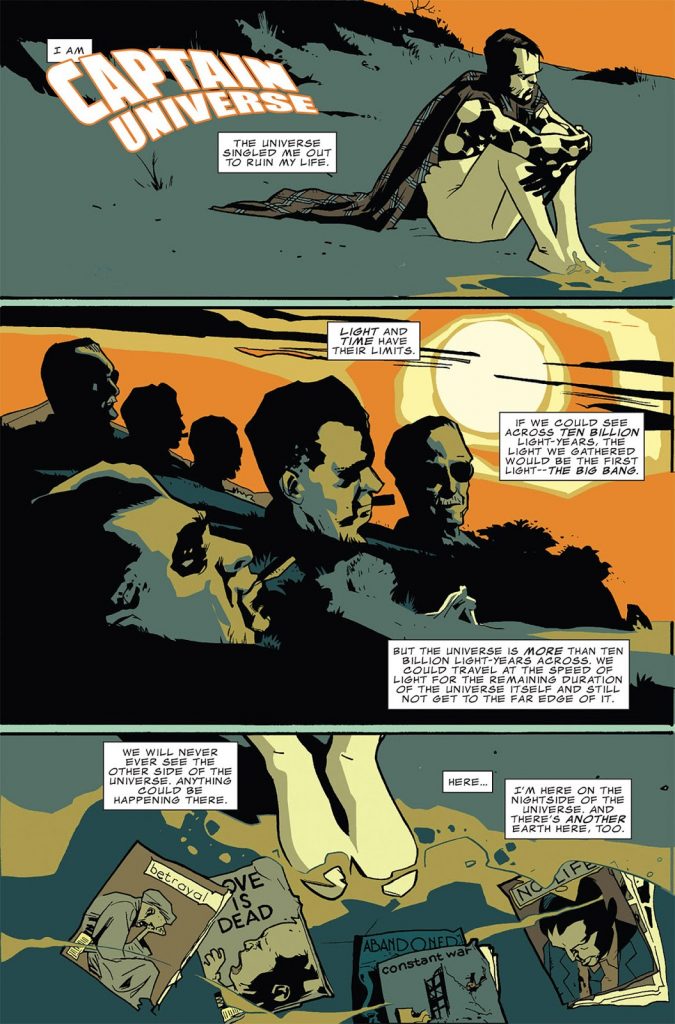
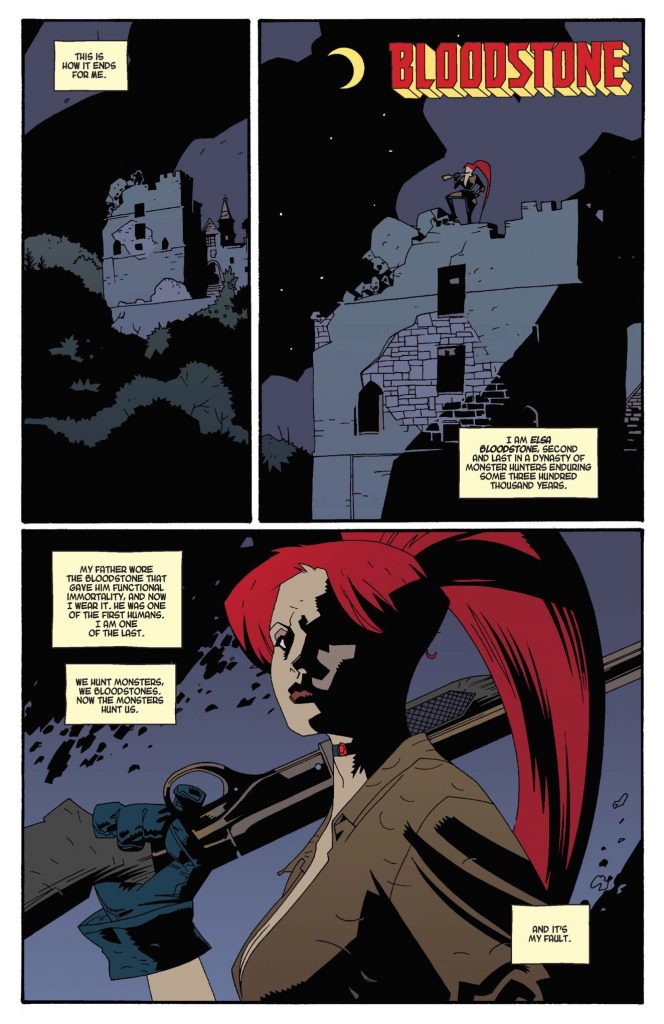
The four style change sequences from Nextwave #10, art by Stuart Immonen, Dave McCaig and Joe Caramagna
“It wasn’t in the script and I was just going to do the sequences ‘straight.’ But when Nick suggested the idea, it seemed obvious,” Immonen said. “And even afterward, I shamefully didn’t give it a whole lot of thought; I just went with first choices. I’m not sure how successful they were as homages, but they stood apart from each other and the rest of the story, so in that sense, they were successful.”
Sava touted this sequence as his favorite from the series, as “you get to see Immonen’s crazy range, and Ellis adjusts his storytelling to match each new aesthetic. It makes the potential of this team feel truly limitless.”
McCaig, for one, loved tackling this section, as he threw in Easter Eggs that even the savviest readers might have missed.
“I loved the five-styles issue,” McCaig told me. “I threw some weird stuff into the halftone backgrounds of the Monica Rambeau section, like Spiro Agnew’s head, and a bunch of pictures of my cat. They mostly ended up under word balloons, but I know they’re there.”
Midway through the series, Eliopoulos became too busy to work on the title, so he passed the book onto another letterer in his Virtual Calligraphy studio: Joe Caramagna. Caramagna viewed this as the hardest section of the book from a lettering standpoint.
“The biggest challenge came in the Forbush-vision sequences when I channeled my inner Daniel Clowes and other letterers by mimicking their style as best I could,” Caramagna said. “That was a pain in the neck to do. I never want to do that again, but was happy with how they turned out. Just those few pages took me all day.”
What Eliopoulos and Caramagna did with the book’s lettering is one of the often slept on elements of the book and how it tried to be different. While it isn’t as immediately noticeable as other things you’d find in the series, it made a subtle 16 difference to how Nextwave connected with readers. Lowe was looking for something graphic and clean on the book, and certainly different. Elioupolous delivered in a major way when it was first coming together.
“Chris did all of the designs of the font captions,” Lowe said. “Chris did the skulls, [footnotes]These were what the book used to censor curse words.[/footnote] he did those cool caption boxes that we always had in there, all that stuff. He and I and Warren went back and forth in the beginning defining the style of it.”
Some of it even confounded a seasoned vet like Eliopoulous, particularly the caption boxes, the skulls they used to censor curse words, and the mixed case lettering that was used to juxtapose the sentence casing most Marvel comics use that Lowe considered more “serious.”
“At first, I was wondering what the heck was going on. I was taking them literally and seriously, but soon realized they were very tongue-in-cheek. We tried to give them a computer pop-up look to the captions,” Eliopoulos said in regards to the caption boxes that delivered meta-commentary of sorts within the book. “Sometimes a letterer comes into a project with no knowledge of what the creators are going for. At first, this was the case for me. I was confused to what they were trying to do, but once I realized it was like a comic in a comic, I got it.”
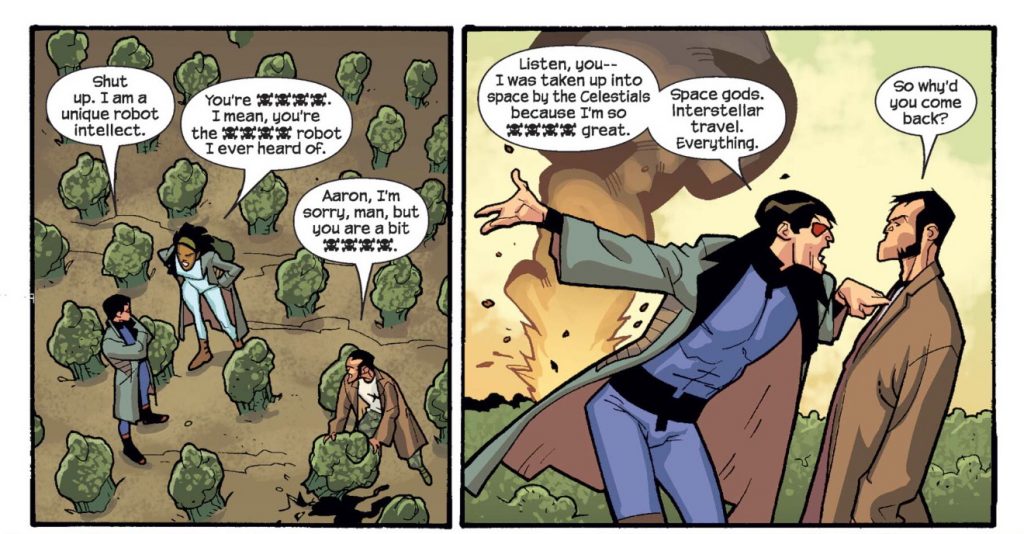
The skulls were even more mystifying to Eliopoulos, and it was an idea from Ellis he whiffed on at first.
“I believe the script even said ‘skull and crossbones’ and I had no clue what he was putting in there. I literally lettered, ‘Get the skull and crossbones ship out of here!’” Eliopoulos revealed. “Then Nick told me that he wanted actual images of a skull and crossbones. So, I created a font that was just the skull and crossbones and used that in those spots. Again, something different and unique that pushes the boundaries of mainstream comics. It became the language of the comic. Part of what made it unique.”
As noted before, Caramagna came onboard midway through the series. He loved the experience of finishing out the series. But his reaction upon getting the book passed to him by Eliopoulos was perfect. It was something like, “What the heck is this?” according to him.
“It was so different,” Caramagna said. “And I heard editor Nick Lowe made a theme song for it. It was wild.”
Speaking of the theme song, let’s look at the story behind that. Caramagna heard right: Lowe did write the theme song—both the lyrics and the melody of it—while his brother performed the instruments on it and his roommates and “the girls who lived downstairs” from them provided vocals for the part where they’re screaming the team’s roll call out. It was an extension of his love of the comic.
“I was trying to think of interesting ways to market it. I ride my bike to work about three days a week over the Queensborough Bridge, and so I remember biking to work writing the first verse or two as I biked. I wrote the guitar riff…you know, (Lowe vocalizes the guitar riff)…I remember singing that out loud as I rode my bike through the streets of Queens and Manhattan as I came up with the first couple verses.”
Nothing sold the book better than Immonen’s art, though. While Ellis was obviously paramount to creating and executing Nextwave, Immonen’s work brought it to life in a way perhaps no other artist could have. Unbelievable Gwenpool writer Christopher Hastings called the series “total unhinged imagination made real,” and in his mind, it was all grounded by Immonen’s art.
“Immonen’s artwork really makes you believe the world is real. I think it’s as good looking a book as any ‘serious’ comic he’s drawn,” Hastings said. “There’s a lot of concepts in the book that are straight up Looney Tunes, but when you present them with that art style, it just makes it all click. It says ‘Yes, this is stupid, but it’s real, and you have to believe it.’”
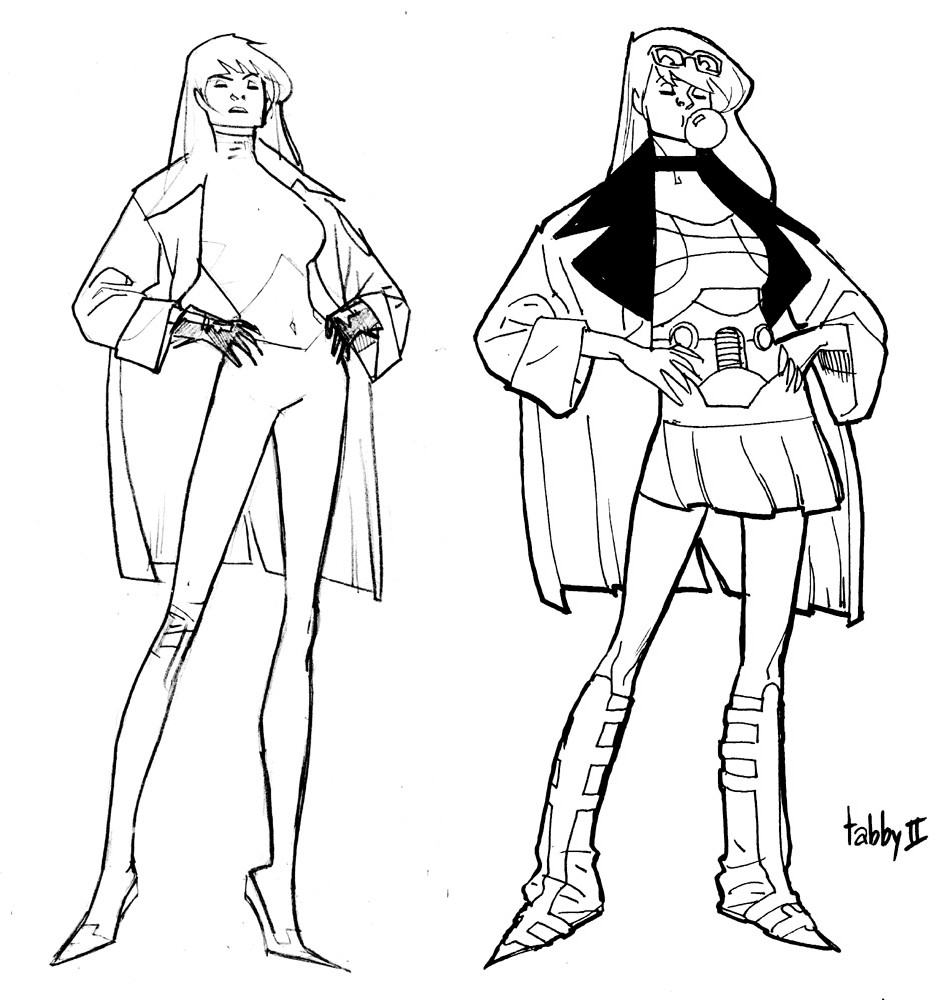
There were showstopper moments throughout the series that could have challenged or even broken some of the most talented artists in comics. But his rare versatility as an artist allowed for sequences like the aforementioned multi-style one in issue #10 to soar and his storytelling chops made the six straight double page spreads in issue #11 work. Lowe said he “cannot imagine” Nextwave without Immonen, saying there’s no one like him both in his abilities and the fact he was quick enough to draw all 12 issues.
This is where it’s important to note something about Immonen in general. I’ve talked to a lot of comic artists in my life, and there are few that are more talented than Immonen and even fewer who are more modest about those gifts. Take when I asked him about the design of the Etheric Loop Recall Televocometer, an absurdly huge phone H.A.T.E. leader Dirk Anger 17 uses when it is lowered down upon his head like it’s Cerebro but for very basic communication. What went into that?
“Warren’s script had been very explicit about this scene, and it was definitely helpful to me to have the tone set up front,” Immonen told me. “It was clearly ‘anything goes’ at that point, which was both liberating to and demanding of my comparatively limited imagination.”
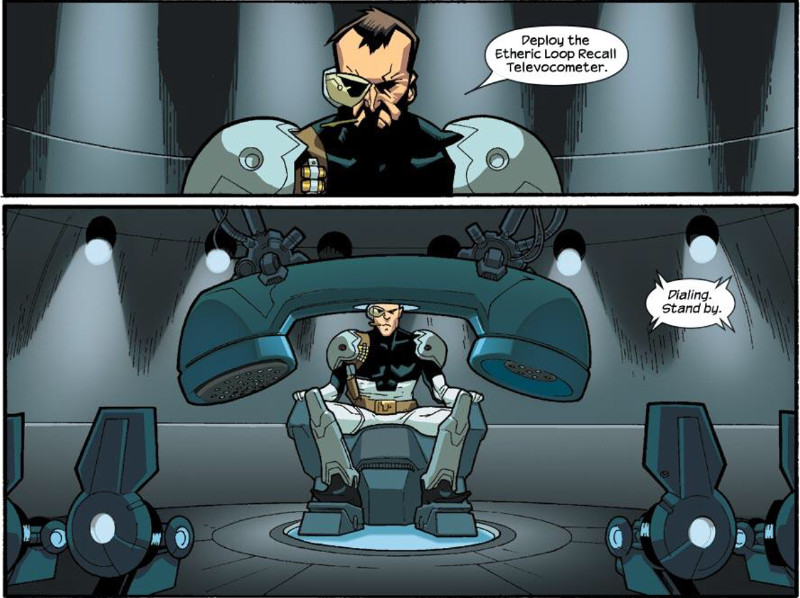
While Immonen won’t say it, I will: even if Ellis described much of what was depicted, Immonen’s fierce imagination made Nextwave soar as it did, and as Hastings noted earlier, his art also grounded it, making something as insane as a massive phone helmet feel like a part of this world in a way few could. Immonen mentioned to me that, “Bizarre stuff like that was easier than wrangling more banal sequences in other projects,” and the good news for us is bizarre was standard operating procedure for Nextwave. This was a series that found Immonen jumping from strength to strength, even if he was typically modest about it. He even made the lives of his collaborators easier, as McCaig shared.
“The shapes he uses to construct his forms are a dream to color, because all of the geometry is so simple and well thought out. He’s good at breaking up visual planes in a panel too, which makes it really easy to set up lighting and mood,” McCaig said.“Nextwave pages took almost no time to color, despite all the crazy halftones and whatnot I threw in.” 18
Maybe the most atypical element of the book from the art side, though, was what led off each issue: the covers. As Lowe told me, “The things Stuart did on the covers…we just wanted him to do something crazy, and boy, did he go crazy on those.” These covers were graphic and absolutely mad, feeling like a collage of gorgeous art and iconography that perfectly represented the world of Nextwave.
“(Immonen) sent five or six concepts before he sent a cover sketch, saying ‘what these covers could look like.’ And they’re mental. They’re absolutely mental,” Lowe shared. “And the actual cover sketch itself is pretty much just what he did. The Great Wave is there. The kind of wallpaper-y top.”
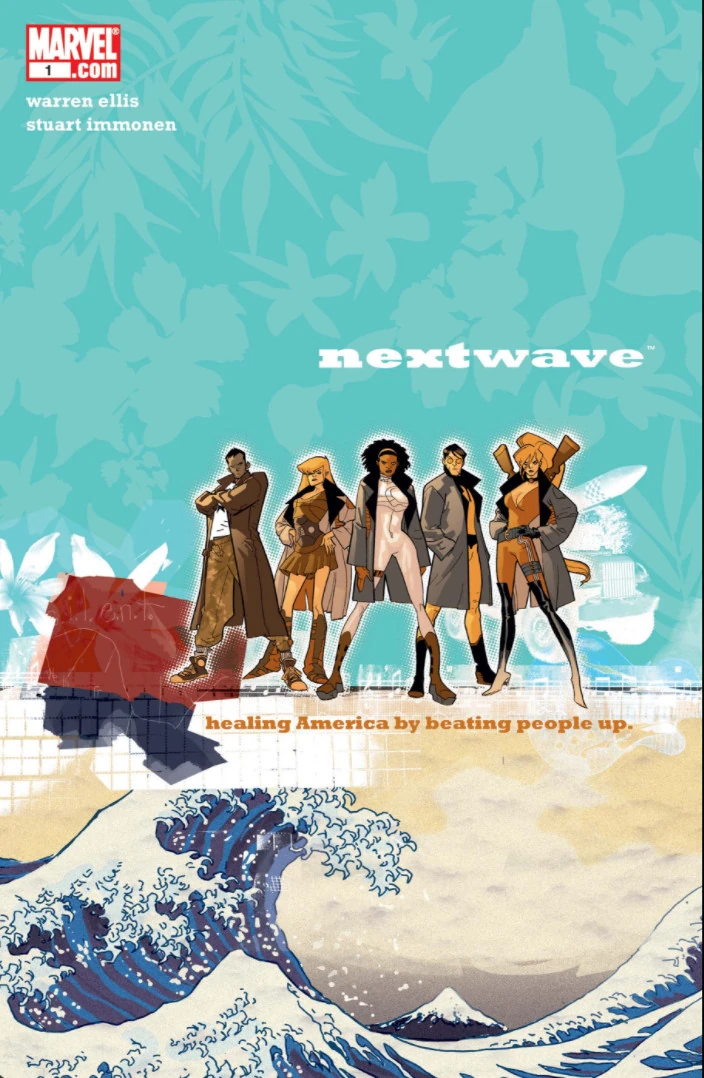
The incredible thing is the usage of key iconography like Hokusai’s famed woodblock print The Great Wave off Kanagawa and the wallpaper elements on that first cover weren’t Immonen reusing graphics; it was his recreation of them. That fit the vibe he was going for on the covers.
“I wanted it to have a DIY zine aesthetic, and just be a jumble of elements, hopefully with some sense of cohesion and composition, but also to have an unfiltered energy that is easier to achieve by someone who doesn’t have any idea what they’re doing,” Immonen said. “The only common element throughout the covers was the ratio of upper and lower sections, 3/5ths and 2/5ths, except for the Civil War spoof cover, which was evenly split and irritated me as a result. 19 The rest of it was me just exploring what I could do with Photoshop layers, sometimes dozens of them.”
There was one little thing Immonen had to change from his initial cover sketches, and it was a rather key detail: the title of the book.
“We solicited it as just Nextwave first. And we got a call and a cease and desist from the Nextwave Festival at Brooklyn Academy of Music because they have this Nextwave Festival, and they said they were going to sue us for trademark infringement or something like that,” Lowe told me. “Our legal team was like, ‘We’ve got to change the title.’ And I was like, ‘oh no,’ because the term Nextwave was actually a villain group from the 90s that Warren had found.
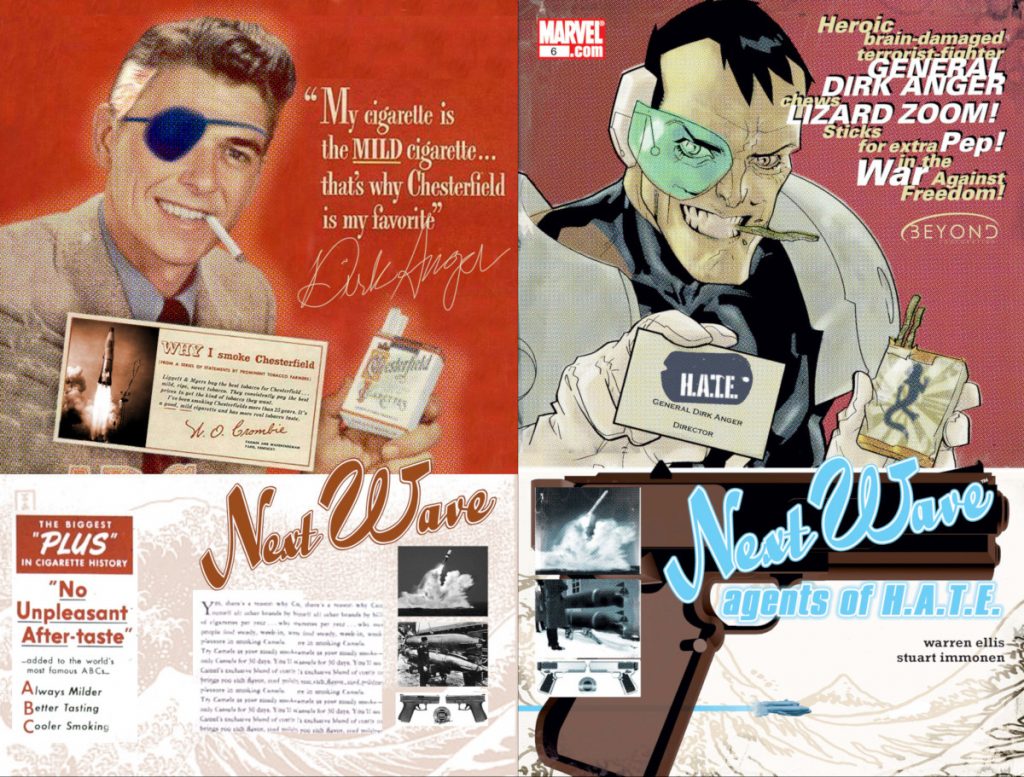
“I think it was Warren’s suggestion (of) what if we called them Nextwave: Agents of H.A.T.E.? Is that enough? And our lawyers said “yep, that’s enough.” That’s why it’s Nextwave: Agents of H.A.T.E. on all the covers and stuff like that.” 20
Despite all of the brilliant ideas and virtuoso talent on the book, the series never really took off. Its final issue was one of Marvel’s ten lowest selling titles of the month it came out, sandwiched between the debut of Legion of Monsters: Werewolf by Night and the fifth issue of Amazing Spider-Girl, both of which were not exactly notable releases. This wasn’t a cancellation, though. Marvel was willing to keep the series going, despite it not being “a runaway commercial success,” as Lowe called it.
The problem was both Ellis and Immonen are A-list creators with page rates to match, and that made the series unsustainable with both of them on the book. Because Ellis was the fulcrum of the series, he and Lowe discussed continuing with a different artist, but Lowe shared Ellis wouldn’t do it without Immonen, and he believed Immonen wouldn’t have wanted to do it without Ellis. So that was that. Nextwave was finished.

Worth noting: in a post about the end of the series, Ellis said, “What (Marvel) found was that, at our current sales levels, they could afford for me to write it, but not for Stuart to draw it. Stuart, as a Marvel-exclusive artist, commands a fee commensurate with his astonishing talent. I’m WFH-exclusive too, but they just send me whisky and loose women and I’m fine. So, basically, I could continue to write Nextwave, but we’d need to find another artist.” That post became the on record explanation for the series finishing when it did, but the idea that it was Immonen’s rate in specific that led to its conclusion is one the artist bristles at.
“This is a frustratingly persistent myth based on an off-hand remark of Warren’s, which I’ve tried—unsuccessfully, obviously—to disabuse people of over the years. I think the other part of that statement was Warren claiming he’d happily work for a bottle of scotch, which is clearly not true, but no one remembers that,” Immonen told me. “While it’s true that comics have budgets and that income and expenses are important factors, it bothers me that I am seen as being the sole cause of Nextwave’s termination.”
Nextwave: Agents of H.A.T.E. ended in February of 2007 with its 12th issue. Despite Ellis suggesting in a post on his site that there would be more of the series to come in the form of recurring minis, it has yet to return. Yet, it persists in a way that contradicts its relatively meager sales, with those who have read it preaching the gospel of Nextwave to any comic fan that will listen. Why is that? What made it stand the test of time in a way other low selling titles ever do? A huge part of that, of course, was that it was good, and that stemmed from the creators at the core of it.
“It’s Warren and Stuart, two of the greatest comics creators around,” Eliopoulos said. “Put them together on a quirky, not-quite-normal book and it ticks off something in some people’s brains.”
For Immonen, it was the “collaborative platonic ideal,” as he mentioned before, and that’s because of how he and Ellis worked together.
“I really do appreciate that writers are coming from a place of generosity when they offer to have a penciller contribute ideas, or when they want to tailor stories to your perceived strengths,” Immonen said. “But after a long time in the business, I’ve found that I’m happier in a kind of film editor role, taking raw material and teasing nuances out of it, trimming or padding as required, or sometimes taking it in a different direction than as originally intended. I know the general wisdom is that collaborators with one perceived unified vision creates an ideal work, but for me, it’s just as interesting when there’s some friction between writer and artist.”
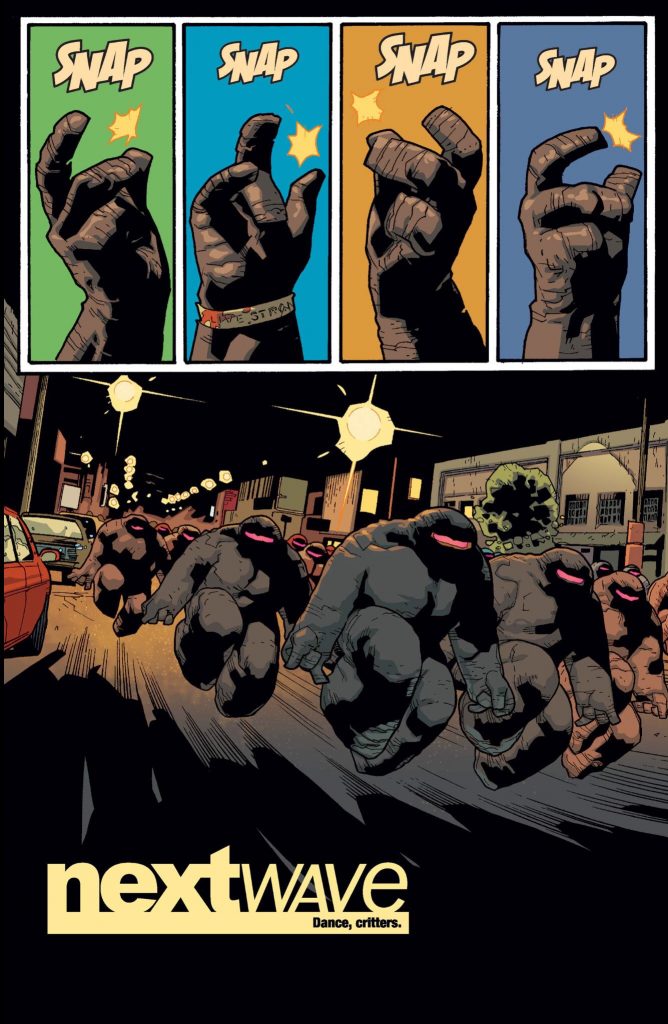
Lowe thought it was essential that everyone had as much fun on the project as they did—and he emphasized that everyone had a blast, which was confirmed by the creators I spoke to—but he viewed Immonen as the one that really kept it together.
“There were times where it drove us all crazy and where we were down to the wire and all that kind of stuff that happens. But not as often just because of Stuart,” he said. “Stuart is the great equalizer. He makes things go well.”
On the flipside, Immonen shined the light back at Lowe, saying, “It’s all down to Nick’s enthusiasm for the project. He led by example, going above and beyond, going to bat for us internally at Marvel and doing work on his own time, like writing and recording the theme song. I can’t think of another editor as willing to sacrifice, cajole, support and champion his creators as Nick.”
For both Hastings and Guillory, they believed the project worked because of how different it was allowed to be, even if it was still quintessentially Marvel.
“I think on a deeper level, it works because it feels like the dream of someone who has lived for decades with the Marvel universe, it takes everything that’s in there and mixes it up in a way that you’ve never seen before,” Hastings said. “It doesn’t feel like it should be allowed but you can’t deny the foundation for all of it was there from the beginning.”
“I’ve always loved how Nextwave feels like a creator-owned comic that takes place in the Marvel Universe,” Guillory told me. “There’s a certain amount of liberty the creators were clearly given here, and it makes the work feel very cohesive and delightful. It is very much its own thing, and I think that’s why it works.”
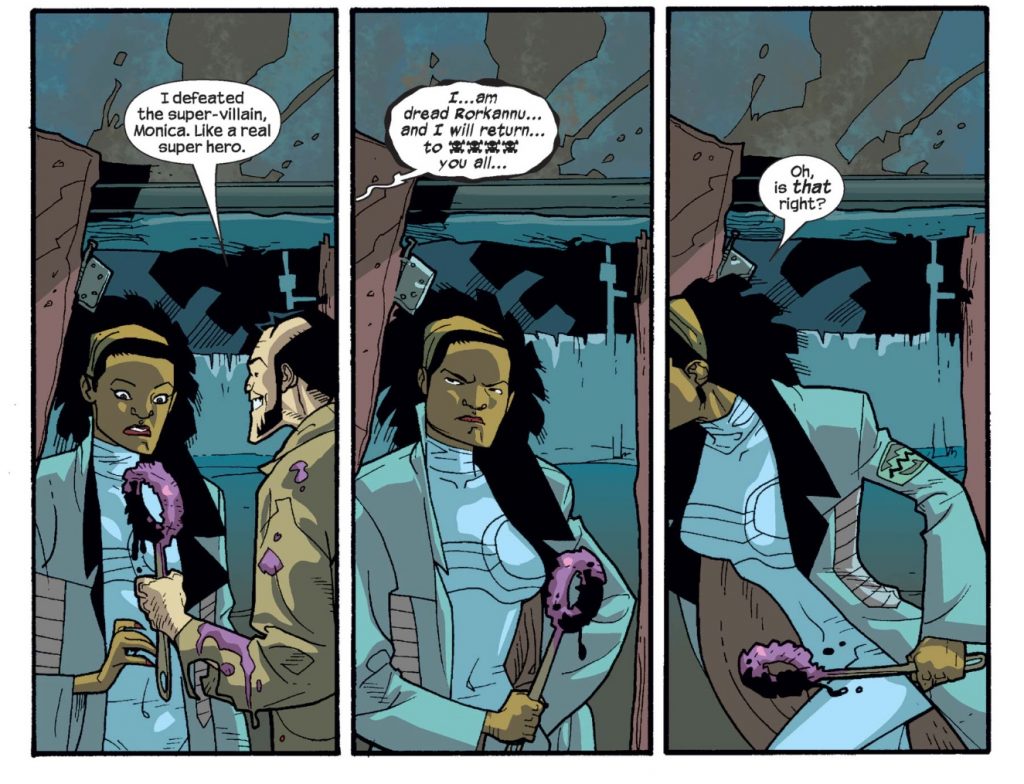
Lowe compares Nextwave to the bands other bands love that never make it big, which matches Caramagna’s perspective, who equates the title’s beloved nature amongst a certain set of comic fans to “having a secret handshake with other people.” That insider nature has made it a favorite for current Marvel creators, with Lowe saying, “more and more of (Marvel’s) writers who are coming to prominence bring it up as their favorite book. It’s something we always knew or hoped would happen.”
Yet, as noted in the beginning, it’s still one Marvel series that just has never come back. 21 While some of the characters have made sporadic or even regular appearances in the comics, with Rambeau even appearing in the Captain Marvel movie, 22 the title and team have not returned.
There have been some close calls, of course, as Immonen said a “couple of years ago we got very close to returning to the characters, but scheduling demands on all sides got in the way.” Lowe thinks about it regularly, but noted that whenever he does, “either the people I talk to aren’t really that interested, they’re intimidated by it or I get second thoughts and I’m like, ‘I don’t know.’ It’s so hard to fill either role (Warren or Stuart’s).”
But it’s top of mind enough he’s known internally at Marvel as the person who brings Nextwave up all the time, with Lowe saying that it’s a regular joke in their offices that if they make a list of the best Marvel stuff, he’ll invariably tout this series. There’s a big reason why. In his 17 years at the House of Ideas, Lowe shared that he’s “worked on some amazing books, and some I’ve enjoyed so much, and I love what I do. I love so many of the books I’ve worked on.
“And Nextwave is by far my favorite book I’ve ever worked on.”
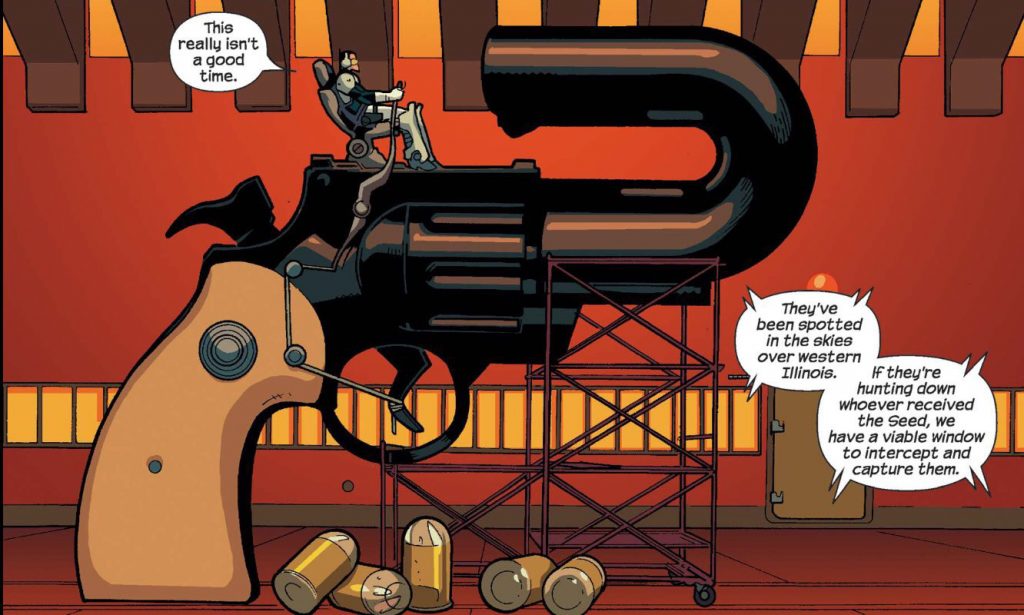
It makes him protective of the series, just like he was with another cult classic that eventually did return.
“I think every other editor here would face a big problem, kind of like (with) Runaways,” Lowe said. “I didn’t start Runaways out. That was C.B. (Cebulski). I edited the last two arcs of Brian’s run and then all of the Joss and Terry Moore and Kathryn Immonen. But for years, things would come up and people would try and I’d smack down other attempts at people doing Runaways. I think Wil Moss was mad at me for a few years when I kept him from doing something Runaways.
“I’d been trying to find a new Runaways things, when I finally learned that (it was Rainbow Rowell’s) favorite, I held up for two or three years for her, batting back Wil Moss – especially because he’s a huge Runaways fan – from doing something himself,” Lowe added. “Nextwave is kind of the same thing. I think people are too afraid that I will take physical action against them if they try to do a Nextwave thing.”
Given the right situation, it could come back. But the question becomes should it return? It really depends on who you are asking and who is making it.
“I think it might lose its charm if the wrong people took it over, and I think (it) might suffer from the joke getting drawn out too much if it were turned into a regular series or something,” McCaig said.
Sava views it as very much of its time, and that if it did return, it would need to “be something new that doesn’t try to replicate the tone of the original, but carries on the spirit.” That said, he did add, “If Ellis and Immonen wanted to revive Nextwave, I would be first in line for my copy.”
“I’m good with it being done, if only because I can’t see how they could top the original,” Guillory shared, before adding, “But if they were to do a sequel, I’d be the first to plop down my hard-earned cash to get it!”
Hastings “would love to see Nextwave’s return,” but it would need a top team to make it work, in his mind.
“The moment you have a writer trying to imitate Nextwave instead of making their own, it falls apart. If you have an artist that isn’t as good at everything as Immonen, it falls apart,” Hastings shared. “I would be stunned if Marvel put their resources to that kind of vision ever again, at least branded as Nextwave. I think we see its influence in a lot of other books though. 23 We might just have to be happy with those ripples.”
Even if Nextwave never returns, its legacy is still important, if only for the titles and creators it inspired over its 12 issues. During its run, this insane, unforgettable story laid the groundwork for some of our favorite Marvel comics of the past few years, and almost certainly, ones still to come. It proved, as Eliopoulos noted to me, “there is room within the superhero comic genre for something different.”
“And sometimes, you get something really unique, like Nextwave.”
Thanks to Immonen, Lowe, Caramagna, Eliopoulos, McCaig, Guillory, Hastings and Sava for talking with me for this piece. Shouts to Kieron Gillen for this article’s title, which I totally stole from him (and I told him I would!).
Slapstick has had a series since then! Slapstick!↩
Again, Slapstick has had a series since then!↩
According to its own theme song.↩
I think?↩
Ellis declined to speak to me for this piece, as he prefers not rehashing previous works in such a way.↩
About which Ellis specifically said in the pitch document, “One story arc makes a European book, three makes a trade paperback, six makes an Absolute style book sort of thing.” That’s brilliant. The structure is truly one of the secret sauce elements of the series.↩
Joe Quesada.↩
An anime/manga series.↩
I’m pretty sure he’s talking about M.O.D.O.K., but I could be mistaken.↩
Besides from Captain America, who team leader Monica Rambeau suggests “doesn’t like girls.” Shouts to the Stucky truthers out there.↩
She does relentlessly remind her teammates of her time in the big leagues, though.↩
He’s mostly referred to as “The Captain,” but Lowe did confirm that his oft censored real name is in fact “Captain Shit,” although that did change depending on the situation.↩
When asked why he used Fin Fang Foom, Ellis replied, “He’s a giant dragon in purple underpants. How can you not want to use him, really?”↩
Who canonically ate his original best pal Moon Boy, per Nextwave!↩
Besides Smith, who apparently lacked a mind, which was advantageous in this situation.↩
And sometimes not so subtle.↩
This is his first mention in this piece, but it’s worth noting that Dirk Anger, a Nick Fury spoof, is perhaps the best character in the entire series.↩
The halftones were a big thing for McCaig, as the rest of the team wanted “bright and crazy” when it came to the colors, and he felt that “Nextwave hearkened back to the sort of goofball light-hearted stuff DC used to do in annuals in the 50’s and 60’s. I felt that halftones kind of paid tribute to that era.”↩
According to Lowe, “The Civil War idea was all Warren. That was the most specific image he wanted and probably the only cover he asked to be involved in. Mainly to try and get his Mark Millar playful dig in.” It also necessitated that even split on the cover because of how Civil War tie-in covers were designed.↩
Lowe thought all of this was hilarious, even if Marvel’s lawyers probably didn’t.↩
Despite, and I hate to bring this up again, Slapstick getting another series.↩
As a child, of course, but they were definitely setting her up for a bigger role in the sequel.↩
Including Hastings’ own work on Unbelievable Gwenpool.↩
